You are using an out of date browser. It may not display this or other websites correctly.
You should upgrade or use an alternative browser.
You should upgrade or use an alternative browser.
A Glorious Union or America: the New Sparta
- Thread starter TheKnightIrish
- Start date
Threadmarks
View all 207 threadmarks
Reader mode
Reader mode
Recent threadmarks
Chapter One Hundred and Fifty Nine The Long Road Home Chapter One Hundred and Sixty A New Beginning Part I Chapter One Hundred and Sixty One A New Beginning Part II Chapter One Hundred and Sixty Two A New Beginning Part III Chapter One Hundred and Sixty Three The Emperor is Enthroned Chapter One Hundred and Sixty Four The Emperor's Coat-tails Part One Chapter One Hundred and Sixty Five The Emperor's Coat-tails Part Two Chapter One Hundred and Sixty Six The Consuls of His Empire
Chapter Eight You Can Forget Kentucky The Battle of Mount Vernon - Part I
Chapter Eight
You Can Forget Kentucky
The Battle of Mount Vernon - Part I
From “The Kentucky Campaigns of 1862” by Professor Dickson S. Foote
LSU
LSU
“The Battle of Richmond is now, as it was then, overshadowed by the Battle of the Rappahannock in the East 3 days earlier and the Battle of Mount Vernon 7 weeks later. Yet Edmund Kirby Smith achieved at Richmond the nearest thing to a Cannae scored by any general, North or South, in the course of the whole war.
The aftermath of the battle had an immediate effect on the direction of the campaign in Kentucky. William “Bull” Nelson withdrew the pitiful remainder of his force to Lexington. In the meantime Churchill and Cleburne sought Bragg’s guidance as to their next move. Smith’s injuries, initially perceived to be minor, quickly had a debilitating effect on the General who was subsequently evacuated to the hospital at Knoxville…
Smith had sought to use his independent command to acquire personal glory at the expense of the campaign’s original objectives. Now, in the absence of the commander of the Army of Kentucky, Bragg had at last command of a united force…”

From “The Life of General William J. Hardee – Teach Them How to War” by Christopher L. Pike
Bison
Bison
“Bragg had initially planned to gather his forces at Versailles, but Buell was coming on too quickly. Bragg refused to bring on an engagement until he could unite his command with that of Smith’s. It was then that Bragg decided to give ground to Buell, all be it slowly. In the meantime he needed an officer to take command of Smith’s force. Cleburne was a foreigner, and no professional. Churchill was supposed to have performed well at Richmond, but he was unknown to Bragg. Therefore Bragg resolved to appoint Hardee to the command, elevating Simon Bolivar Buckner to command of the Right Wing of the Army of Mississippi…Hardee’s instructions were clear – to withdraw south along the main road from Richmond to met up with Bragg’s force somewhere in the vicinity of the Mount Vernon crossroads…
Hardee was impressed with both of his new subordinates. The reports he obtained direct from the brigade and regimental commanders reflected luster on their reputations... Hardee quickly established a solid working relationship with both men, that developed into a friendship that would serve the three men well over the course of several campaigns…
From “The Kentucky Campaigns of 1862” by Professor Dickson S. Foote
LSU
LSU
“Buell was coming on with an uncharacteristic rapidity. Little did Bragg know that Buell had actually been relieved by General Halleck and replaced by George Thomas. Thomas however had refused to relieve Buell “mid-campaign”. In an attempt to redeem his reputation Buell pushed his three corps on in pursuit of Bragg following the line of the Old Wilderness Road south east to Danville and beyond…Gilbert’s III Corps in the lead skirmished with Bragg’s rearguard, under Cheatham, at Stanford and Crab Orchard…
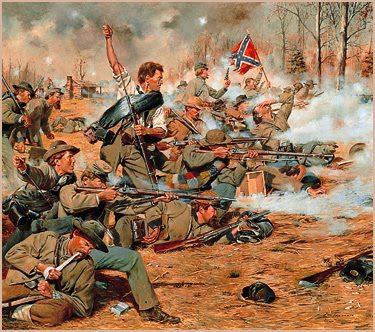
Bragg ultimately settled his forces on the hills west of the village of Mount Vernon. His right flank rested a top the high ground at Hysinger Farm behind the Linville Creek. His line then ran south west making good use of the forested high ground behind the Maret Cabin and the Sayer Farm, before finally curving in a short "hook" at the end of line pointing north west around a bowl of low ground, finally coming to rest at Carl Brown’s Farmhouse…Behind Bragg the Richmond road ran south through Mount Vernon. If Bragg was to link up with Hardee this was the place to do it…
Gilbert’s performance was to become a byword for incompetence on 17th October, but even before that day Gilbert had consistently failed to send out proper scouts. The engagements at Stanton and Crab Orchard had both been surprises. He knew he was on Bragg’s heels, but he had no idea that Bragg had stopped and deployed until he ran head long into three of Patton Anderson’s brigades straddling the Old Wilderness Road and the heights on either side…
Buell hurried to the sound of the guns. His three corps were spread out on two narrow rutted roads, if road was not too an exaggerated term for them. In the words of Thomas, riding with Buell, “we all hoped Gilbert was just getting another bloody nose”. The Battle of Mount Vernon had begun…
Last edited:
Disturbingly I have realised I have now sketched out the political landscape and presidential election tickets up to and including 1884... . I better get a move on.
. I better get a move on.
Chapter Eight You Can Forget Kentucky The Battle of Mount Vernon - Part II
Chapter Eight
You Can Forget Kentucky
The Battle of Mount Vernon - Part II
From “The Kentucky Campaigns of 1862” by Professor Dickson S. Foote
LSU
“The Old Wilderness Road, or Brodhead Road as it sometimes called ran south east towards Mount Vernon. To the south west the ground quickly rose and it was littered with little stream and creeks which had worn unseen scars in the lands. To the south there was an open triangle of land (subsequently called Sayer’s Bowl after the Sayer Farm there) and beyond that there rose the Brown Ridge (a grandiose name for the rising ground upon which Carl Brown had built his farm) and Marek’s Hill adjacent to the road. Just across the road rose Jones' and Liddell’s hills (named after the brigade commanders who initially occupied them). Between these two hills rose Linville Creek flowing north east. On the east bank was Hysinger’s Hill. Linville Creek then became Renfro Creek and flowed, in its meandering fashion, north. On its east bank was the North Wilderness Road which led to Richmond…”
“Cheatham had placed his troops on the reverse slope of Brown’s Ridge with the left end of his line anchored on Brown’s Farmhouse by Wheaton’s Cavalry and the right on Sayer’s Farmhouse by an advanced company of D.S.Donelson’s Brigade. Cheatham had the Bowl covered in an enveloping field of fire. Patton Anderson was next in line, straddling the road. He occupied Marek’s Hill and cabin on the left and Jones’ Hill to the right of the road. Slightly further back on his right was Buckner’s old division. Liddell occupied Liddell’s Hill in Anderson’s right rear. Then on Hysinger’s Hill, just behind Linville Creek, were the other three brigades, including Wheeler’s cavalry. Bragg made his headquarters at the Hysinger Farm just west of the village of Mount Vernon…”
“The area to the north of the road was marked by three streams, Long Branch, Bowman Branch and Boone Fork. But beyond the cluster of these streams, and to the north of the road, was a slightly elevated plateau of land and fields clear all the way to Renfro Creek and the North Wilderness Road…”
“Schoepf blundered into Adams brigade on the road. He tried to shake his division into line as a crescendo of enveloping fire opened up from Marek's and Jones’ Hill. Adams had even tried to turn the cabin into a block house in the limited time available to him. Gilbert sought to bring Mitchell up on Schoepf’s right to relieve the pressure. Instead Mitchell’s men stumbled into the Bowl where the fire was worse than that experienced by Schoepf…”
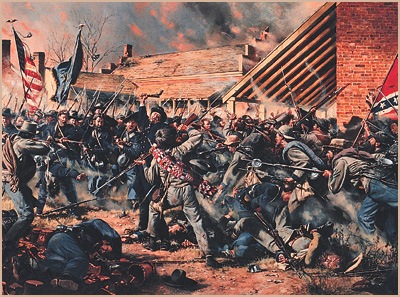
The 82nd Indiana tries to take Marek's Cabin from the 13th Louisiana
As Sheridan came up, Gilbert ordered him into the bowl, “Sir you are to take that high ground [Brown’s Ridge]”, “General Gilbert, sir, that is a cauldron from which my men will not emerge. We should look for their flank sir”, “General Sheridan you have your orders. Attack or I will relieve you” (Col. D.McCook) and so went Sheridan’s Division into the Bowl…”
“Buell realised this was no rearguard skirmish. One sight of the hell into which Gilbert had sent Sheridan and Mitchell convinced him that his right was not the place to turn the rebels' flank (though indeed it was perhaps his best chance if he could only have found Cheatham's left flank). He therefore led Wood and Van Cleve north of the road, shook them out and had them advance south east towards Mount Vernon. The lack of accurate maps or scouting work meant that Buell had no idea the advance would be interrupted by the Linville Creek or Buckner’s Division, although the high ground beyond (Hysinger’s Hill) could be seen…”
“Smith was still back at Brodhead advancing as quickly as he was able. Jackson and Rousseau were still on the Negro Creek Road marching in from the west. It was about midday and it would be at least an hour, and perhaps two before Buell could expect Rousseau or Smith to arrive. In the meantime a runner from Van Cleve brought disturbing news – there were more troops coming down from the north along the North Wilderness Road and the leading elements were deploying into line. The implications were clear. The Army of Kentucky had arrived and Hardee meant to sweep into the rear of Crittenden’s two divisions and cut the road before reinforcements could come up or Buell could extricate himself…”
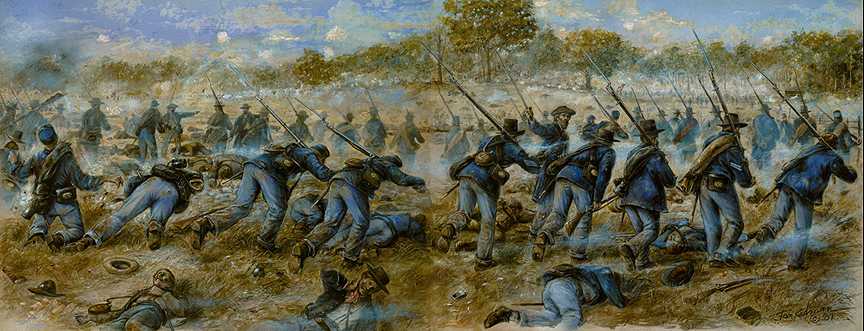
Mitchell's Division marches into the "Bowl"
From “The Life of General William J. Hardee – Teach Them How to War” by Christopher L. Pike
Bison
“General Hardee sent 4 messages to Bragg over the next two hours, and 2 to Buckner. “The enemy is seeking to disengage and withdraw. I am in a position to cut some or all off. Press your attack and advance. Do not let them disengage…”. Bragg did not respond nor did he order an advance. As it was Churchill and Cleburne moved quickly to cut the road, gathering up scores of prisoners from Van Cleve’s, Wood’s (including Wood himself) and particularly Schoepf’s Divisions. Sheridan managed to pull his troops out and in doing so advised Mitchell to follow, which Mitchell did in direct breach of orders to stand from Gilbert.
Such a performance should have pleased Hardee, but he was incensed. As indeed was Buckner who had asked for permission to advance beyond his lines on receipt of Hardee’s direct request. As word spread that Bragg had missed an opportunity to bag “the lion’s share of Buell’s sheep” [Col. Joe Wheeler] the whole army became angry and disturbed…
Many have suggested that Bragg’s inaction was a result of professional jealously. Hardee would have been the one to cut the road and take the prisoners. Might not then the glory reflect on him and not on Bragg? Bragg’s detractors have long maintained envy and incompetence played their parts. However to stand at the Hysinger Farm, from which Bragg fought the battle, is to stand out of sight of the plateau over which Hardee advanced; and out of sight of the Bowl where Anderson and Cheatham were chewing up Gilbert. Bragg’s reluctance to advance may be explained by his ignorance of the success of his defence, the remoteness of three of Buell’s eight divisions, or perhaps the fear of leaving exceptionally strong defensive positions for a running battle in broken ground…”
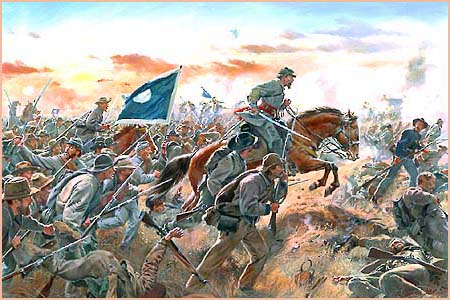
Cleburne and Churchill advance
From “The Most Hated of Men – Braxton Bragg in the Civil War” by Grafton Lowe
University of Kentucky
University of Kentucky
“Bragg remained largely silent on his reasons. Any desire to explain himself evaporated in the open hostility now being shown him by the majority of the senior officers in his army. He had won a decisive victory over Buell, who was now in retreat. But he was short on supplies with a fractious command. The question for Bragg was complex: advance on Louisville; pursue Buell; or withdraw and resupply – Eastern Kentucky had not been the land of milk and honey, or recruits, he had been expecting. Winter was near at hand and Bragg had a quandary. Little did he know the decision would soon be taken out of his hands…”
Last edited:
Lol, I just imagined 67th Tigers throwing his Monitor to the ground in rage.Knocking out McClellan is always the hallmark of a great TL. Keep it up.
I have absolutely no idea which way this war will go now. It can't be a straightforward US victory. like OTL; but I can't see a CS victory either.
I have absolutely no idea which way this war will go now. It can't be a straightforward US victory. like OTL; but I can't see a CS victory either.
Really - I am actually expecting Kearny to beat much Lee sooner in this timeline.
Chapter Nine We Are All Wet Alike The Rapidan Campaign - Part I
Chapter Nine
We Are All Wet Alike
The Rapidan Campaign - Part I
From “The War Between the States” by Otis R. Mayhew
Sword & Musket 1992
Sword & Musket 1992
“In the fall of 1862, and in the midst of three campaigns (Kearny’s Rapidan Campaign, Grant’s Vicksburg Campaign and Rosecrans’ part in the Kentucky Campaign) the Union Army under went a substantial reorganisation. Twenty four corps were created numbered I through XXIV. Each of these corps was assigned a symbol for the purposes of identification. This had been a enthusiasm of General Kearny’s when he had been a divisional commander, and he had extended it to the Army of the Potomac on his appointment to command. It had been well received and General Halleck rolled it out to the army as a whole. In each corps the first division’s would red, the second white, the third blue. In the rare instances where fourth and fifth divisions existed these were later assigned green and yellow respectively…
Major General Fitz John Porter was assigned to the Department of the Gulf with a corps strong force and headquarters at New Orleans. Major General Ambrose Burnside was appointed to command the Department of the South with a reinforced corps of 5 divisions, and responsibility for South Carolina, Georgia and Eastern Florida. Major General Irvin McDowell was assigned to the Department of Virginia with his headquarters at Suffolk. He commanded a further corps with responsibility for Eastern Virginia and North Carolina…
Lincoln had several meetings with General Kearny. Halleck had not met Lincoln’s idea of a commander in chief. So Lincoln began to treat him as a “Chief of Staff” and began to run his own strategy…
Lincoln was not satisfied that a victory of sufficient magnitude had been won upon which to base the issue of his Emancipation Proclamation. He desired a victory over Lee before the new year. Kearny, with initial reluctance, took the President into his confidence.
“Richmond, from its moral importance, is the point which will prove the most decisive, and to carry with it the Valley of the Mississippi, as Grant intends, would isolate the war to little more than South Carolina and parcels of the extreme secession states. I intend to either turn out Lee from Richmond or trap him there until his army withers on the vine. To that end I plan to turn his flank in the west. First General Reynolds will secure the Shenandoah Valley so we will not have a hostile valley at our backs and then I will turn Lee’s flank near the Orange Court House. And if Lee should split his forces to stop Reynolds I will wedge this army between the split elements and defeat them in detail. It may not happen overnight. We may be hostage to the weather Mr President, our movements slowed by rain and mud. But so will Lee’s. I will not halt this movement simply because of poor weather…”
Kearny had assigned Reynolds I Corps to the valley, with von Steinwehr’s IX Corps and Buford’s Division of the new cavalry corps. Reynolds was also permitted to call upon Generals Heintzelman and Wool, the commanders of the Washington and Middle departments for reinforcements as needed…
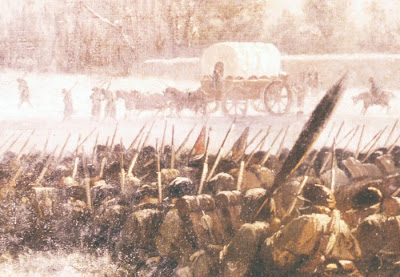
Kearny had requested that diversions be staged by McDowell and Burnside to distract troops from crucible of the coming campaign, but Halleck’s orders left the timing vague and the discretion to the local departmental commanders. In the end little was done in time to support Kearny’s campaign…
Last edited:
Chapter Nine We Are All Wet Alike The Rapidan Campaign - Part II
Chapter Nine
We Are All Wet Alike
The Rapidan Campaign - Part II
We Are All Wet Alike
The Rapidan Campaign - Part II
From “Yankee Dawdle - the Memoirs of a Private of Pennsylvania”
Cadogan 1891
“A brief spell in the luxury of a former cattle truck on the O&A has forever made me fond of the smell of manure. We only traveled as far as Warrenton, and then it was out into the driving rain. We marched from Warrenton, over Carters Mountain and past Baffle Mountain. Then we passed over Thornton’s Gap. I say passed over. Our brigade was near the front so I only had to wade up to my knees in mud. The poor Dutchmen in the rear swam uphill and were washed down again. Having lost my boots several times in the mud I realized they made a better necklace and marched on foot sole. I am told that mud is good for the skin so I was surprised my feet were no smoother by the time we squelched into Luray. It was in Luray I saw General B and his cavalry. Carrying the poor beasts they were, foot sore and weary, I could not tell who was horse and who was horseman…
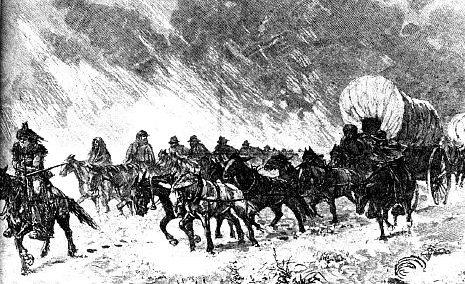
The Dutch left us at Luray and pressed on to New Market with the poor American Horse. General R had of course kept the sophisticated European Horse Gentlemen with us, Cols. PW and AD. An Englishman and a Frenchman to keep we amateurs right. So down we went a far as Milam Gap and there one night while General R decided whether to keep on south on our watery holiday in the Valley or cross the gap to visit our seccess neighbors I met a Georgia Bull. Says he to me “Do you know who I am? Why I’m a senator, secretary, general and what’s more I’m a Georgia Bull!”. Says I to him “Why sir if you don’t stand still I'll elect you with this here patented Yankee voting stick!”
From “The Battle of Milam Gap” an article by Jeff Trembly in North & South Magazine
2011
“Reynolds had to rely on the Cavalry Brigade of Colonel Wyndam for intelligence. In the horrendous rain and sleet the Colonel’s men had not stirred far from the main column, its fires and supplies. So when Reynolds' cold and tired men stumbled towards the Gap in the middle of the night they had no idea they were stumbling into the cold and tired men of Jones’ Division of Longstreet’s Corps. General Robert Toombs of Georgia was the first casualty of the night when wandering from the main column, to relieve the call of nature, he had a “political disagreement” with a "ragamuffin" of the 13th Pennsylvania Reserves, and was taken a reluctant prisoner…”
“Jones’ Division received a bloody repulse from Reynolds who moved faster, getting Meade’s and Doubleday’s Divisions into place first and gaining control of the gap. The “highlight” of the battle however was the charge of Wyndam’s Brigade from some dead ground on the leading elements of Drayton’s Brigade of Jones’ Division which looked like breaking through…”
From “Yankee Dawdle - the Memoirs of a Private of Pennsylvania” by Anonymous
Cadogan 1891
“If two more dapper gentlemen ever invited a Southern Belle to the ball I never meet them. But then I’m a Northern Belle and likely wouldn‘t know.
In they went, sabers and mustaches flying European style, to invite the Rebs to dance. And dance they did on the end of those big old cavalry razors. And them that couldn’t find a partner tore off back down the road to Madison. And so General R had his victory at the hands of two of the biggest goddam fools in Christendom. But they can’t take all the credit, for the Rebel General must have been more cold and stiff than our General R, for I never saw him all night but that he moved like lightening…”
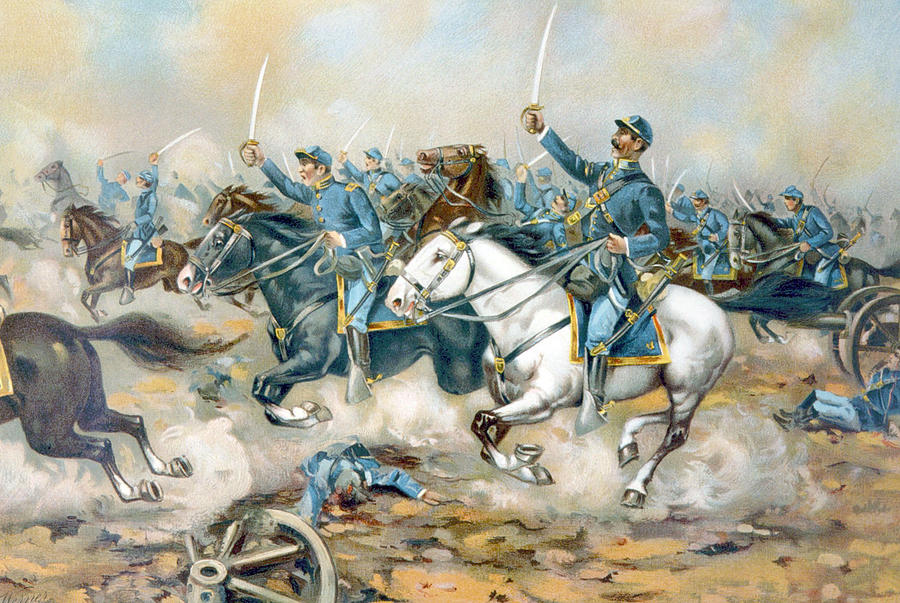
One of the many stylized depictions of "Sir Percy's Charge"
Last edited:
Chapter Nine We Are All Wet Alike The Rapidan Campaign - Part II
Chapter Nine
We Are All Wet Alike
The Rapidan Campaign - Part II
We Are All Wet Alike
The Rapidan Campaign - Part II
From “Three Victories and a Defeat - Kearny and Lee in the Fall of 62” by Carl Zeigler
Georgetown Press 1972
“The efficiency of Lee’s cavalry under Stuart was without question. Stuart’s troopers were masters of the art and science of light cavalry. In the case of scouting and intelligence Lee was extremely well informed as a result. He knew that the I and XI Corps had withdraw from the Rappahannock line. Captured and traded Yankee newspapers suggested the XI Corps was returning to Washington to recruit (indeed the third division under the newly minted Brigadier General Schimmelfenning had). The ultimate destination of I Corps was less clear. “General Reynolds is fine gentleman, and a better officer. Where he goes, he goes to fight. I must know where the I Corps goes” as Lee told Stuart.

Kearny’s appointment had, and continued to, cause General Lee concern. Kearny was no sluggard like McClellan. Nor was he a fool like Pope. Kearny was a more dangerous opponent and Lee knew it. On 11 November when Stuart reported that the bulk of the Union Army was departing north Lee knew Kearny was not retreating. An advance; an attack of some kind was in the offing.
Sedgwick’s V Corps and Reno’s IX Corps remained behind. Sedgwick covering the fords west of Rappahannock Station, and Reno those east. Wynn Davis and Pleasonton were also still “lurking about” according to Stuart who sent Hampton to investigate Fredericksburg only to find Pleasonton waiting for him…
A few days later the first reports from the Valley arrived. Cavalry and large formations of infantry had chased off the militia from Luray and New Market. The reports of lootings and burning in New Market confirmed Lee’s worst suspicion that the Dutchmen of IX Corps were abroad in the valley. But to what end? A concentration of Union forces in the valley would expose Washington and Baltimore to an attack. So what then? Perhaps Kearny had been forced to split his forces as McClellan had. An attack on the Shenandoah would give the Yankee newspapers something to crow about, but a weakened Kearny might feel the need to draw off Lee a little bit. "If it was McClellan", said Lee, “I would know it was a retreat to winter quarters and I would release Jackson once more into the valley to deal with the invader. But this is Kearny and I do not his mind yet.”
In the end Lee sent Jones and Walker’s Division of Longstreet’s Corps towards Milam Gap to secure that passage to the Valley and investigate the Yankee threat. Stuart was to dispatch Fitzhugh Lee’s Brigade via the Swift Run Gap with similar instructions. “Get me all the intelligence you can on the forces and disposition of the invader”.
Jackson, however, was convinced Kearny was in retreat. “General, if we press Sedgwick he will withdraw. Let us push at him, at all the fords. I’ll find where he is soft and push hard. He will fall back and then we can cross and chase these invaders back to the Potomac”…
From “The Maverick - General D.H.Hill” by Duncan Frasier Jones
Buffalo 1988
“Daniel Harvey Hill did not get on with Jackson. He had ample indication to be certain in his own mind that Jackson neither liked nor trusted him. Jackson never consulted or explained. He simply ordered. D.H. Hill often wrote he was not fit for the army life for he despised taking arbitrary orders. As a result Hill hated Jackson about as much as Jackson seemed to distain Hill…
Jackson arrived in person to give Hill his orders: to attack Beverly Ford head on; to push the northerners defending it to see if they would stand; a reconnaissance in force; a reconnaissance to the other side of the river.
“General Jackson, I do not need to attack the ford head on. I shall merely go around it.”
“General Hill, my orders are clear. You will comply. Or I will relieve you. You will attack the ford as ordered come the morning.”
It was perhaps an instinctive response for Jackson then paused, turned to look Hill in the eye and tilted his head [all according to Doctor Hunter McGuire of Jackson's Staff].
“General, how can you go around the ford?”. General Hill then led General Jackson to some nearby wagons laden with rough looking boats and loose planks.
“We have been idle here for two months General so I put the men to making something of a pontoon train.”. Jackson’s response is reported to have put the normally acidic Hill in a sunny mood for days.
“Well done General. You may proceed as you have suggested. I will pray for your success”…

D.H.Hill's troops appear on the flank
From “Three Victories and a Defeat - Kearny and Lee in the Fall of 62” by Carl Zeigler
Georgetown Press 1972
“The Battle of Oak Grove was a shambles for the Union. Sedgwick had intended to give way slowly and orderly. General Morrell, who commanded the First Division of V Corps, was fully briefed on the plan. Morrell however was ill and had relieved himself to depart for Washington. General Daniel Butterfield was appointed to the command. He was at Sedgwick’s headquarters that morning being briefed on the plan himself when the sounds of gunfire were heard. The First Division was under attack from the far side of the river by John R. Jones’ Division. A short time later it was attacked by D.H. Hill’s division on its own side of the river. Hill had crossed out of sight by way of an improvised pontoon bridge.
Brigadier Charles Griffen was the senior officer, but he did not know it. Forty minutes and more passed before he took command and ordered a withdrawal, but not before the division had taken a thorough mauling. Sedgwick and Reno withdrew north east up the line of the railroad. Not in the orderly fashion envisaged, but in a running fight with the lead elements of Jackson’s Corps which were continually at their heel. Sedgwick could not even save the supplies at Warrenton as planned. These were burned as Sedgwick and Reno settled on the other side of Cedar Run. The pall of smoke could be seen for miles. Lee and Jackson were exultant. Kearny had miscalculated surely. Even the arrival of Longstreet with the balance of his Corps and the news of Milam Gap could not completely quell their optimism.
As it was, the running fight to Cedar Run served Kearny’s purpose better than he could have planned…”
Last edited:
The remaining two victories of the "Three Victories and a Defeat" chapter will come tomorrow. I wonder whether they will belong to Lee or Kearny?
I would also would like to hear if anyone wants to read more from Private Anonymous of Pennsylvania in his book "Yankee Dawdle"?
I would also would like to hear if anyone wants to read more from Private Anonymous of Pennsylvania in his book "Yankee Dawdle"?
I would also would like to hear if anyone wants to read more from Private Anonymous of Pennsylvania in his book "Yankee Dawdle"?
Very much.
A whirlwind of alternative battles. Despite the detailed battle descriptions and the specific scope of the textual context to individual warriors, the title betrays a rather grand theme/story that will be developed.
I must have more.
I must have more.
Chapter Nine We Are All Wet Alike The Rapidan Campaign - Part III
Chapter Nine
We Are All Wet Alike
The Rapidan Campaign - Part III
From “Three Victories and a Defeat - Kearny and Lee in the Fall of 62” by Carl Zeigler
Georgetown Press 1972
“As Kearny’s remaining corps had marched north from the Rappahannock, leaving Sedgwick and Reno behind, the question was asked “who knows where we are bound?”. Lincoln’s own papers clearly indicate he knew and had taken Stanton into his confidence. General Halleck did not know and it would appear no other members of the cabinet were informed. Of Kearny’s lieutenants Oliver O. Howard knew. As chief of Kearny’s staff he had to know, and Kearny clearly trusted Howard to remain silent. John F. Reynolds knew all, the better to conduct his critical operations in the valley. John Sedgwick had had a part of the plan explained to him so that he could better understand the role he would play but as he said to Jesse L. Reno “I know but a portion of the plan and it clear to me that it is the least part of it”. For all his claims in later life there is no evidence that Joe Hooker had been brought into Kearny’s confidence. Kearny trusted Hooker to fight, but not to keep confidences. “He is more political than a hundred senators” was a frequent refrain of Kearny…
“The weather was atrocious but the evidence was that Kearny intended to keep the men marching, and marching hard, for the wagon train carried “a cobbler’s lifetime of shoes and boots” (Major George Armstrong Custer of Kearny’s Staff)…
“Some marched and some entrained to Warrenton. Then the first surprise order came. “Westwards”. The rumours and newspapers had said Fredericksburg, a surprise flanking manoeuvre to cross the Rappahannock. Others had said it was back to the Peninsula. A few more eccentric characters had suggested the Shenandoah Valley to follow Reynolds. The march westwards inflated the perceived wisdom of the eccentrics among the rank and file, but concerns were raised among the officers:
“Washington will be exposed, and Baltimore too”, “What possible sense is there to march this army into the Valley where it could barely deploy?”, “Lee will crush Sedgwick and Reno while they are isolated”, “An advance down the Valley takes us away from Richmond and Lee!” (Taken from the Gentlemen Officers – Letters from the Potomac by George Hazard, Kennedy Publishing 1963)…
The cavalry brigade of Colonel Benjamin F. Davis did sterling work. With Buford in the valley and the bulk of Pleasanton’s troops distracting Stuart around Fredericksburg in the east, it was left to Davis to screen the march. Screen it he did, between Carters and Baffle Mountain, then between Baffle and Red Oak Mountain. Finally, as the army approached Sperryville and Thornton’s Gap, Davis turned south to Woodbridge, screening the army from Red Oak Mountain to the Hazel Run. His troops were barely noticed. Lee was chasing Sedgwick and what he hoped was Kearny’s rear. Stuart was at Fredericksburg sparring with Pleasanton. Fitzhugh Lee was south, in the valley, while Jones’ force was in retreat to Madison Court House. But one person was taking note of Union movements near Red Oak Mountain. He was calling himself John Lowrey, but he was known to the Secretary of War in Richmond simply as Harrison…”
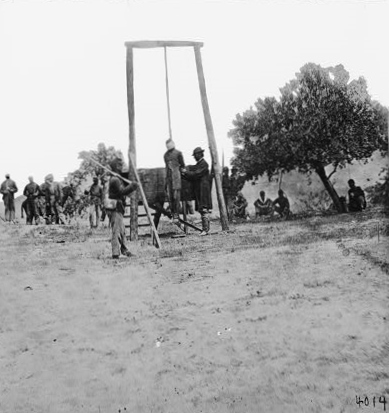
From “Spies: Lies and Misdirection in the Civil War” by Major James Pearson
Bison 1991
“Harrison was taken by a Captain Brewer in Benjamin F. Davis’ brigade. He was dressed as a well to do farmer, had a saddleback full of greenbacks, and week’s worth of Northern newspapers. Davis immediately concluded Harrison was a spy. He sent an orderly to Kearny for instructions. “Hang the damnable man. Immediately” was Kearny’s response. His comment to Howard, who suggested a tribunal or referral to Washington, “We hang spies here Oliver. It is a coward’s profession, and a rogue’s tool. He shall be hung without further discussion and let him explain his cowardly profession to the almighty, and when this campaign is over let it be known that such is the fate of all spies masquerading as civilians in my Department”. It was the first of such executions under Kearny’s reign. It was not to be the last…”
From “Three Victories and a Defeat - Kearny and Lee in the Fall of 62” by Carl Zeigler
Georgetown Press 1972
For a day the army sat at Sperryville within sound of the Battle of Oak Grove. For Kearny and many of his officers and men it was a difficult day. It was not in their nature to sit idly by within sound of a battle…
Instead over crossing over Thornton’s Gap the army turned south on a neglected old turnpike towards Hazel Run and Slate Mountain. The route was narrow and full of mud. The engineers and sappers worked day and night to improve and maintain the road. Speed was essential, but in a cold wet November near miracles were asked of the engineers. In the end the army successfully crossed the Run with its artillery and wagon train largely intact. Passing between Slate Mountain and Turkeyhole Mountain the army was now west of Culpepper Court House and technically well in Lee’s rear…”
From “Yankee Dawdle - the Memoirs of a Private of Pennsylvania” by Anonymous
Cadogan 1891
“What a surprise: we crossed over German Ridge down to Robertson’s Creek, expecting Rebs and meeting Old Magnificent. Why I nearly shot one of his staff to be sure they were real. In the end the rain, and a damp charge, saved me from some difficult conversations with the provosts and my Colonel.”
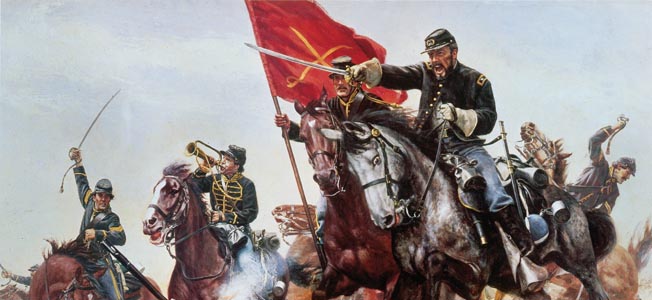
Colonel Benjamin F.Davis attacks Culpepper
From “Three Victories and a Defeat - Kearny and Lee in the Fall of 62” by Carl Zeigler
Georgetown Press 1972
“With no need for secrecy now, Davis and Wyndham joined together to raid and burn Lee’s supplies at Culpepper Court House. It was the first indication to Lee had that Kearny was in his rear. Lee could not advance further, though Sedgwick and Reno might just be vulnerable, for he was far in advance of his supply train. Jackson, initially keen to attack across Cedar Run regardless, was quick to sense Lee’s concern. Jackson undertook to act. His foot-cavalry would march south and stop Kearny before he could cross the Rapidan. Longstreet was notably sceptical: the roads were a mess after two armies had passed over them; the weather was abysmal and worsening; and Kearny was two and perhaps three days marches ahead of Jackson. Having little choice Lee ordered Jackson to be off…”
Last edited:
The Crucible of War - Good (but not perfect) map of Virginia
Anyone looking for a good map of Virginia I am using this:
http://mapas.owje.com/maps/9580_virginia-civil-war-battlefields-map-1891.html
but bear in mind it is a 1891 map, so some of the railroads and roads do not exist. It is the most detailed one I have been able to find so far.
Anyone looking for a good map of Virginia I am using this:
http://mapas.owje.com/maps/9580_virginia-civil-war-battlefields-map-1891.html
but bear in mind it is a 1891 map, so some of the railroads and roads do not exist. It is the most detailed one I have been able to find so far.
Anyone looking for a good map of Virginia I am using this:
http://mapas.owje.com/maps/9580_virginia-civil-war-battlefields-map-1891.html
but bear in mind it is a 1891 map, so some of the railroads and roads do not exist. It is the most detailed one I have been able to find so far.
Detail. That's the watchword for this TL. Yours is incredible.
I like it. An advance to the west of Richmond cutting off the Shenandoah Valley and its easier to get at Richmond's rail links. But it also gives Lee more room to operate initially.
I wonder if Kearny's high handed execution is indicitive of anything? Kearny I the Magnificent - American dictator? Hmmm made not. Too radical for a TL that seems very real and plausible so far.
I wonder if Kearny's high handed execution is indicitive of anything? Kearny I the Magnificent - American dictator? Hmmm made not. Too radical for a TL that seems very real and plausible so far.
The Rapidan Campaign - Part IV
Did we miss Part III?
Nope. I just can't count. Thanks for paying attention though!
Threadmarks
View all 207 threadmarks
Reader mode
Reader mode
Recent threadmarks
Chapter One Hundred and Fifty Nine The Long Road Home Chapter One Hundred and Sixty A New Beginning Part I Chapter One Hundred and Sixty One A New Beginning Part II Chapter One Hundred and Sixty Two A New Beginning Part III Chapter One Hundred and Sixty Three The Emperor is Enthroned Chapter One Hundred and Sixty Four The Emperor's Coat-tails Part One Chapter One Hundred and Sixty Five The Emperor's Coat-tails Part Two Chapter One Hundred and Sixty Six The Consuls of His Empire
Share:
